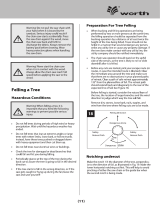
CUTTING INSTRUCTIONS
FELLING A TREE
When bucking and felling operations are being performed by two or
more persons, at the same time, the felling operation should be
separated from the bucking operation by a distance of at least twice
the height of the tree being felled. Trees should not be felled in a
manner that would endanger any person, strike any utility line or
cause any property damage. If the tree does make contact with any
utility line, the utility company should be notified immediately.
WARNING: Check the tree for damaged or dead branches that could
fall and hit you during felling.
Before any cuts are started, pick your escape route (or routes in case
the intended route is blocked); clear the immediate area around the
tree and make sure there are no obstructions in your planned path of
retreat. A clear path of safe retreat is approximately 135 degrees
from planned line of fall. The retreat path should extend back and
diagonally to the rear of the expected line of fall. (Fig. 21)
Before felling is started, consider the force and direction of the wind,
the lean and balance of the tree, and the location of large limbs.
These things influence the direction in which the tree will fall. Do not
try to fell a tree along a line different from its natural line of fall.
The chain saw operator should keep on the uphill side of the terrain
as the tree is likely to roll or slide downhill after it is felled.
Remove dirt, stones, loose bark, nails, staples, and wire from the
tree where felling cuts are to be made.
NOTCHED UNDERCUT – Cut a notch about 1/3 diameter of the
tree, perpendicular to the direction of the fall. Make the cuts of the
notch so they intersect at a right angle to the line of fall. This notch
should be cleaned out to leave a straight line. To keep the weight of
the wood off the saw, always make the lower cut of the notch before
the upper cut.
WARNING: Do not fell trees during periods of high wind or heavy
precipitation. Wait to do your cutting until the hazard has ended.
WARNING: Do not cut down trees having an extreme lean or large
trees that have rotten limbs, loose bark, or hollow trunks. Have
these trees pushed or dragged down with heavy equipment, then cut
them up.
FELLING BACK-CUT ( Fig 22,23,24)
The back-cut is always made level and horizontal, and at a minimum
of 2 inches (5cm) above the horizontal cut of the notch.
Never cut through to the notch. Always leave a band of wood
between the notch and back-cut (approximately 2 inches (5cm) or
1/10 the diameter of the tree). This is called “hinge” or “hinge wood.”
It controls the fall of the tree and prevents slipping or twisting or
shoot-back of the tree off the stump.
On large diameter trees, stop the back cut before it is deep enough
for the tree to either fall or settle back on the stump. Then insert soft
wooden or plastic wedges into the cut so they do not touch the chain.
The wedges can be driven in, little by little, to help jack the tree over.
Fig. 21
Fig 22
As the tree starts to fall, stop the chain saw and put it down
immediately. Retreat along the cleared path, but watch the
action in case something falls your way. Be alert for overhead
limbs or branches that may fall and watch your footing.
WARNING: Never cut through to the notch when making a
back-cut. The hinge controls the fall of the tree, this is a section
of wood between the notch and back-cut.
BUCKING
Bucking is the term used for cutting a fallen tree to the desired
log length.
Always make sure your footing is secure and your weight is
distributed evenly on both feet.
Cut only one log at a time. Support small logs on a saw horse or
another log while bucking.
Keep a clear cutting area. Make sure that no objects can contact
the guide bar nose and chain during cutting, this can cause
kickback.
When bucking on a slope, always stand on the uphill side of the
log. To maintain complete control of the chain saw when cutting
through the log, release the cutting pressure near the end of the
cut without relaxing your grip on the chain saw handles. Do not
let the chain contact the ground. After completing the cut, wait
for the saw chain to stop before you move the chain saw.
Always stop the motor before moving from tree to tree.
BUCKING LOGS UNDER STRESS
When the log is supported along its entire length, it should be
cut from the top or over-bucking.
When the log is supported on one end, cut 1/3 diameter from
the underside or under-bucking. Then make the finishing cut by
over-bucking to meet the first cut.
As the log is being cut, it will tend to bend. The saw can
become pinched or hung in the log if you make the first cut
deeper than 1/3 of the diameter of the log.
Give special attention to logs under stress to prevent the bar
and chain from pinching.
OVERBUCKING – Begin on the top side of the log with the
bottom of the saw against the log; exert light pressure
downward. Note that the saw will tend to pull away from you.
(Fig. 25)
UNDER-BUCKING – Begin on the
under side of the log with the top of the
saw against the log; exert light
pressure upward. During
under-bucking, the saw will tend to
push back at you. Be prepared for this
reaction and hold the saw firmly to
maintain control. (Fig. 26)
Fig. 23 Fig. 24
Fig. 25
Fig. 26
12
Model LCS31440S



















